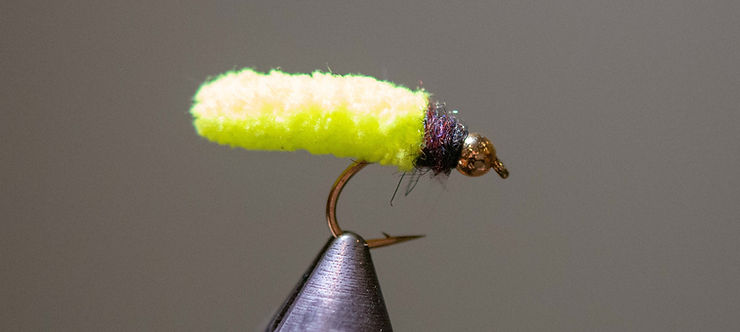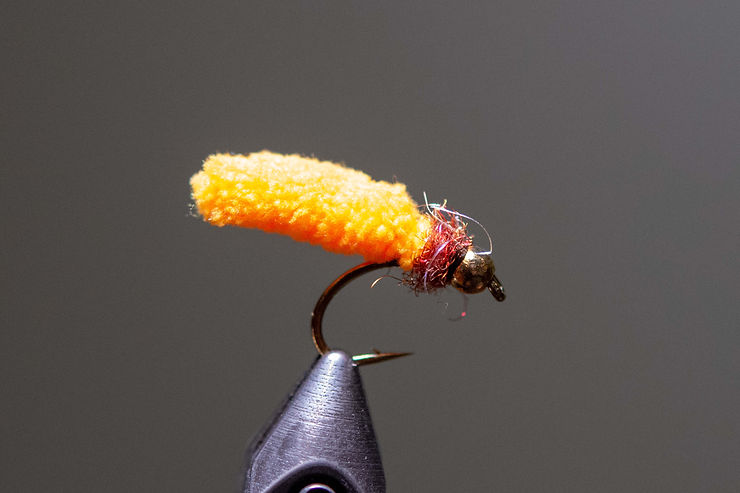How to Tie and Fish the Mop Fly

The term “guide flies” describes flies that can save the day and put fish in the net but are ridiculously quick and easy to tie. The Mop Fly fits the bill on all accounts.
What is a Mop Fly?
A Mop Fly is a very basic design that incorporates strands of microfiber tied to the hook with a dubbed collar. You’ve seen this material even if you don’t remember ever seeing it. Think bathroom rugs, car cleaning supplies, and of course mops.
How to Tie the Mop Fly
Hook: Size 10 Caddis/curved shank hook.
Bead: 1/8 bead of your choice of color. I typically stick with the standard gold bead.
Body: One piece of microfiber mop material about an inch and a half in length
Collar: Dubbing of choice. I tie these with two different types, one flashy and one not. The flashy works well in high off-color water while the more drab one will work in lower and clear water. Also, I don’t think the color of dubbing matters all that much. The biggest “trigger” is that you use contrasting colors. For instance, if you’re using a dark body, then use a light-colored dubbing, and if you’re using a light-colored body, use a dark-colored dubbing.

Step 2: Cut a length of microfiber material. In general, I like a body that is about twice the length of the hook shank or shorter. I’ll explain why this is important later.
Step 3: Pull off the loose fibers on one end to expose the cords. Attach the material to the hook with several securing wraps. If you see that some material appears loose, feel free to dab some head cement or zap a gap to shore things up.
Step 4: Twist your dubbing of choice onto the thread, just enough to completely cover the junction between the material and bead.
Step 5: Finish it off with a few half hitches or whip finishing tool.
Step 6: Catch fish and be happy.
Note that sometimes the material comes in one continuous length, which requires cutting bodies to size, which means that both ends can fray. To prevent fraying at the tail, put a spot of super glue on the end and pinch the fabric together.

You could also use a lighter or match to burn the end, which basically melts the fabric together. I like this method a lot because it does add some realism to the pattern. Caddis usually have a dark head and dark tip on their tail, so a Mop with a burnt end is very realistic.
Variations of the Mop Fly
Microfiber material is a versatile product that serves many uses at the fly tying bench. I’ve seen it used as the body for hopper patterns and I’ve seen it used as a sort of peeking Caddis imitation. One of my personal favorites is to wrap CDC around the collar to simulate a wet fly — a Wet Mop, I suppose — that can be an extremely deadly pattern. The Mop can also be tied on a jig-style hook with a tungsten bead for all you Euronymphers out there.
Fishing the Mop Fly
The Mop Fly is an incredibly versatile pattern. The conquests of the Mop Fly have been well documented on this site and others. Regardless, some anglers snub the fly, claiming that it’s not really a fly at all, just a modified cleaning supply. Others, however, could no more stop using the Mop Fly than they could break any other bad habit — Old Milwaukee beer and cheap cigars come to mind.
How much you enjoy using a Mop Fly probably depends on how much of a purist you are. There’s the group of anglers who welcome any contraption that catches fish while still being legal to use in Fly Fishing Only sections (me!). And then there’s the group who use it grudgingly, not happy with the pattern but pleased with the results. And then there’s the group — weirdos, mostly — who refuses to use them at all because they don’t consider Mop flies worthy of their time.
Fishing the Mop Fly is no different than fishing any other nymph. It can imitate a wide range of insects, from terrestrial grubs to aquatic crane fly larva. I often use it in conjunction with another pattern in a tandem rig, using the Mop Fly as the point and then a more subtle and smaller trailing nymph. I mentioned that I prefer Mop bodies twice the length of the hook shank or shorter. Sometimes, with a longer body, you can get a lot of misses or have too many trout shake off in the way in. This is also why I now tie this pattern on a size 10 instead of the size 12 that I used to use. The larger hook with a more proportioned body will result in more hookups and fish landed. Generally speaking, I use bright colors (chartreuse, orange, pink) for high or off-color water and darker “earthy” tones (tan, black, gray) in low and clear water. The exception to this would be purple, which is an excellent color for all conditions, in my experience.

Sometimes, off the wall colors can work well, too, such as blue. Overall, I feel that blue is a very underutilized color in fly fishing. It’s not always what the trout want, but sometimes it’s all they want. Not catching anything? Try a Mop. This simple pattern is quick and easy tie and catches lots of fish. A good selection of colors belongs in every fly box.
Did You Find This Mop Fly Tying Guide To Be Helpful?
Stay up to date with the Dark Skies Fly Fishing monthly newsletter for free and receive the latest in fly fishing news, tricks, tips, and techniques, stream reports, as well as updates on new flies added to the Online Store and exclusive discounts!
Sign Up Now